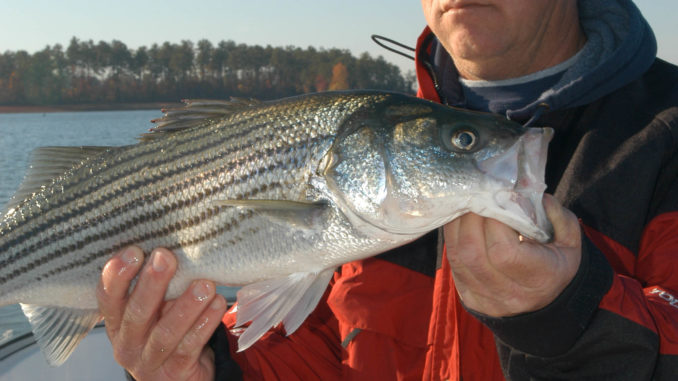
It won’t be long before Guide Buddy Edge of McCormick is ready to put a hurting on the striped and hybrid bass in Thurmond (Clarks Hill) Lake.
“As the lake turns over, it’s gonna get better,” said Edge (803-480-0200). “The fish will turn on, they’ll start feeding, and we’ll start to catch better fish.”
Edge said that fishermen have been catching hybrids and stripers around the mouth of major creeks on the lower end of the lake in 24 to 30 feet of water. Live blueback herring fished close to the bottom on down rods have been the ticket.
“Most of the time, the hybrids and stripers are mixed in; you catch them about 50-50,” said Edge. “And they’ll usually be at the same depth.”
Stripers and hybrids become more active as the water temperature drops during the fall – at least until it gets down into the mid- to lower-40s. On the way down, fish start to spend more time ganged up in pods and schools, working on bluebacks or shad whenever they can find them.
Finding bait is usually a good way to guarantee that you’re going to catch fish, but Edge takes it one step further.
He taps. Drums. Bangs.
Whatever you want to call it, Edge is one of a growing number of striper fishermen who takes a wooden pole with him to tap on the bottom of his boat’s hull. He said it attracts fish – at least enough to pull them off the lake’s floor to find the source of the noise.
“Tapping, that calls ‘em to the bait,” said Edge, who taps the butt of a broomstick on a rubber mat on the floor of his boat. “It makes ‘em come up, but you’ve got to be able to read a depthfinder and know what to do when they’re coming.”
With one eye glued to his boat’s electronics, Edge will tap until he sees the distinctive hook-shape of a fish on the depthfinder’s screen begin to move up off the bottom, toward the depth at which he’s placed his baits. Usually, he’ll stop tapping when a fish starts to approach a bait – his wooden stick has done its job by then.
Stripers will often just brush up against a bait, then return to the bottom, he said. Hybrids that move up to inspect a bait almost always kill it – eating it most of the time.




Be the first to comment